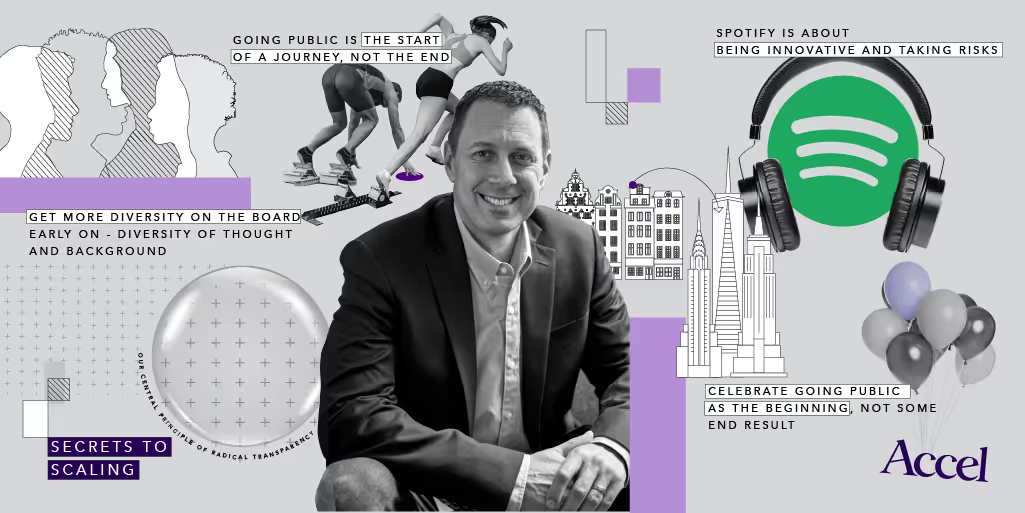“Going public is unbelievably exciting and rewarding…it’s the beginning of something, not the end” – Spotify’s CFO Paul Vogel

This post is part of Accel’s Secrets to Scaling series, where leaders from across our portfolio share their learnings and advice with the next generation of European and Israeli entrepreneurs building global winners.
Spotify changed the music landscape completely when it launched in 2008, revolutionising the way artists distribute their music and the way we consume it. In June 2011, Accel led Spotify’s financing prior to its US launch and, in 2018, Spotify surprised many people when it opted for a direct listing on the NYSE (NYSE: SPOT) rather than a traditional Initial Public Offering (IPO). I caught up (virtually) with Spotify’s Chief Financial Officer (CFO), Paul Vogel, to learn about the company’s experience of direct listing and his tips for companies considering this path to going public...

You and the Spotify team pioneered the direct listing. This had never been done before, so what drove this decision?
The idea for a direct listing grew out of discussions I had with Barry McCarthy, our former CFO. We talked about the process of going public -- what worked, what didn't, and what could be improved. For us, the direct listing was an opportunity to do things in a very Spotify way. We like to be innovative and cutting edge – take risks and experiment. It started with Barry's vision of what we could do differently and what we wanted to accomplish. Spotify was also in a different position than a lot of companies that seek to go public - for starters, we had a strong liquidity position, so we didn’t need to sell shares. We thought, why dilute our existing shareholders if we don’t need liquidity?
A natural question that follows is, if Spotify didn’t need liquidity, why go public?. At that point, Spotify was more than 10 years old. We acknowledged that we needed an avenue to give liquidity for our early investors and employees so that our investors who did want to capitalise on the gains they’ve had or our employees who had been with us a long time were able to sell their shares.
The direct listing was a way to find a real supply/demand dynamic in setting the price of Spotify shares and treating our stakeholders fairly in going public. Finally, we wanted to provide even more transparency than in a traditional IPO and give everyone access to the same information at the same time. We had an investor day prior to going public that was webcast publicly. Everyone could listen and receive the same information as institutional investors and accredited investors. This was important to us. With a direct listing, all our employees and early investors were able to sell on day one, with no restrictions. That put everyone on an equal playing field and worked out well.
This was a completely new process. What ended up being easier than you thought it would be? And what was harder?
The hardest part was that we were the first to do a direct listing - it had never been done before. There was a tremendous amount of skepticism as to our intentions and why we wanted to go down a new route. Second, from a regulatory standpoint, we had to convince the US Securities and Exchange Commission (SEC) and others that this is something that we thought would benefit all shareholders and was in no way negative from that standpoint. All of our filings and financials were exactly as they would have been with a traditional IPO. On top of this, we had the investor day and created four videos on our website to explain why we did the direct listing and introduce Spotify as a company.
We ultimately accomplished our goals by being even more transparent than in a traditional IPO, and having as much financial disclosure and even more company disclosure. But it was a big hurdle to get consensus with different constituents.
What went easier? I don’t think going public is ever easy and, doing it differently definitely throws some curveballs! I think it [the direct listing] set a continuation of Spotify’s path, where we're going to continue to innovate, take risks and do what we think are the right things for our employees, our business, and our company. It set us up on the course we wanted to be on.
Why was Spotify able to do a direct listing? Is this an option for any company?
For us, one of the key reasons we thought we’d be able to do this was thatSpotify was a well-known consumer company with a big brand name. For many companies when they go public, having the recommendation from a reputable investment bank and underwriters who can vouch for your business is very important. Not every company going public is as widely known and as well-understood as we were. Second, because Spotify was 10 years old, we had a fairly active private market for our shares, and they traded hands probably more frequently than most private companies. As a result, we had a good idea of what the company was worth based on actual supply / demand transactions. We felt there was a good reference price and the market had already started to give us a base of what we were worth, which helped the decision.
There’s definitely more work for the company to do in a direct listing that underwriters typically handle in a classic IPO. In a traditional, underwritten offering, there’s as many as five to 10 banks involved in the process. As a result, your story gets pushed out broadly to all of their institutional clients. With the direct listing, we only had three banks working for us, but we had a hypothesis, which proved correct, that our brand and market cap were big enough to get coverage from the sell-side and the banks, even if they weren’t included in our listing. I think we had 15 to 20 banks covering us within the first three months of being public.
It worked out for us, but that may not be the case for some smaller companies. For example, if you’re in a sector that’s not as high profile, or your story isn’t well-known, or you have a smaller market cap, you may not get the coverage you would get if you had a full complement of investment banks supporting your listing.
Why did you pursue a listing in the US, not Europe?
We had that discussion with Daniel [Ek – Spotify co-founder and CEO] - he is very proud of being a non-US company and a European executive. However, the US provided the investor base and the liquidity that we thought we’d need and want. Almost all our major peers are listed in the US. We felt that from a competition standpoint, a liquidity standpoint and an investor standpoint, it made the most sense to list in the US.
Would you make the same decision on location today?
We definitely would.
It reinforced what Spotify is about, which is being innovative and taking risks to move the ball forward and benefit the company.
I think it was very helpful for our employees to see that, as a company, we were doing everything we could to treat them equally and fairly. As much as it was a lot of work, it was fun and very cool to say that we were the first to do something. Clearly, a number of companies have followed in our footsteps, so it’s apparent to us that a direct listing does work and was the right thing for us.
What advice do you have for companies aiming to go public?
Know that going public is the start of a journey, not the end.
The race begins when you go public. This is just one event in the journey of being a business. It’s one that can help you grow because it can provide liquidity, if that’s what you need, and provides you with currency in the market, more publicity and PR and attention, and all these things help your business grow.
People also often underestimate the amount of scrutiny you get as a public company. A lot of executives are not prepared for that, so make sure you’re prepared on how to navigate that.
How long in advance of actually going public should you prepare? What actions require the longest lead time?
It was about a year and a half between the time I joined [Spotify] and when we went public. My experience is that most companies think about their product first to get to scale and then how to monetise it. The last thing they worry about is the actual business model and how to make a profit, grow it and account for it. I think people sometimes underestimate the complexity around the finance function. When you go public you need a very strong finance function and to be able to close your books on time, be confident that the numbers are accurate, and have systems and checks and balances in place. You need to be prepared to go public with audited financials and with a level of confidence that you can do it repeatedly, and without material risk and control deficiencies.
The least glamorous part of the business is the one that often takes the most time, as it’s often – in my experience – the part that’s most neglected. We had to swap out our entire accounting system and move to a new platform before we went public.
What about getting a board that fits a public company?
It’s something companies should start thinking about before they go public.
Get more diversity on the board early on – diversity of thought and background.
We have people on our board who are creative and understand content, people who understand consumers, consumer products and marketing. We also have technologists, and we have people who understand the legal and regulatory side. Having board members who all have varying backgrounds and can all weigh into different parts of the business has been super helpful for us. The earlier you can start that process, the better.
Any final thoughts?
Going public is unbelievably exciting and rewarding. As a company, you should celebrate going public as the beginning, not some end result - know that it’s the starting point for a further acceleration of your business.
This is interview was originally published on Soaked by Slush
Read our Secrets to Scaling interviews with:
- Humio's Geeta Schmidt here
- Zepz' (formerly World Remit Group) Ismail Ahmed here
- Snyk's Guy Podjarny here
- Personio's Hanno Renner here
- Chainalysis' Michael Gronager here
- BlaBlaCar's Nicolas Brusson here
- Supercell's Ilkka Paananen here
- Miro's Andrey Khusid here
- Trade Republic’s Christian Hecker here
Great companies aren't built alone.
Subscribe for tools, learnings, and updates from the Accel community.


